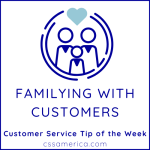Nothing bad at all might happen. Every day in the office could seem like every other day. Sights and sounds and smells might continue to be the same. But we have a lot of construction going on around our offices, and the building manager knows the type of work we do and the number of client calls and meetings we have throughout the week.
The construction doesn’t affect every part of the building all the time, but the building manager wanted to update me on the progress. She told me when my area might be most affected by loud – and I mean LOUD – noise, so I could plan to go offsite if needed, and she asked me to proactively check-in with her if the noise was disruptive or something unusual happened.
She gave me a heads up.
This wasn’t even a warning of what would definitely happen. It was an explanation of what might happen, when it might happen, and why it could happen. She explained things in detail, yet conversationally. She asked me to reach out and let her know if anything unexpected happens or if I had any questions.
This is basically a situation where nothing negative may end up happening to the customer, but the company knows something could happen. Therefore, instead of hoping for the best and not engaging the customer unless the customer came to her with a complaint, she decided to be proactive. She decided to set some expectations. She decided to create dialogue. She had enough knowledge of her customer’s type of business to understand how I might be impacted.
And I appreciated it.
Service recovery is typically what you do to recover after an issue happens, but the building manager engaged before something happened.
This is about being proactive to avoid the complaint, or to mitigate the negative effect on the customer, or to enable the customer to prepare themselves so that they are not inconvenienced, frustrated, or upset.
The next time you’re aware of something with your organization’s products, services, communications, or environment that may negatively affect the customer, let your customer know what to expect. Let them know when things may happen. Let them know how to communicate and with whom to communicate if any difficult situations arise.
Care enough to give the customer a heads up.
Signup for FREE Tips! Contact Us More Resources for You Visit Our Home Page
























